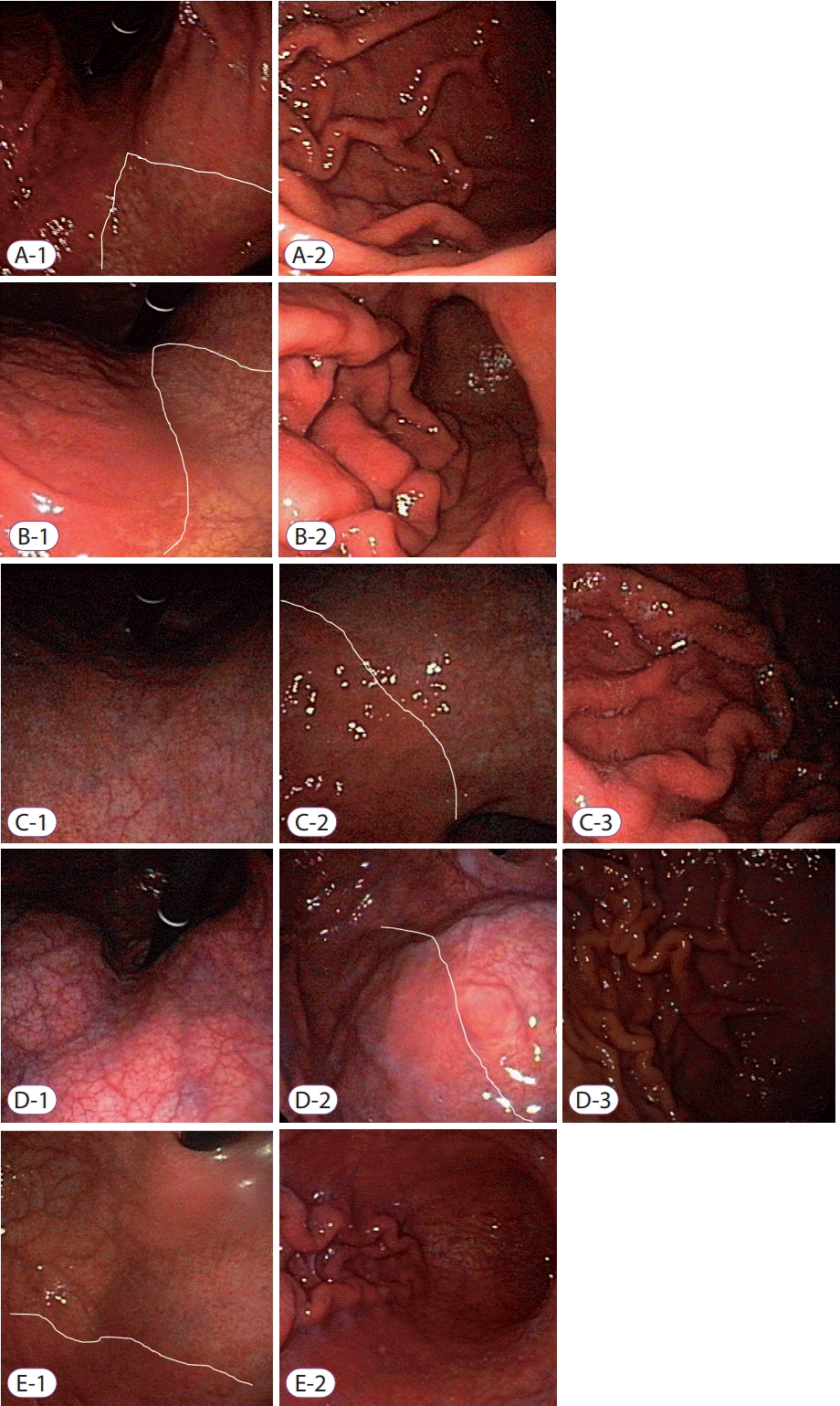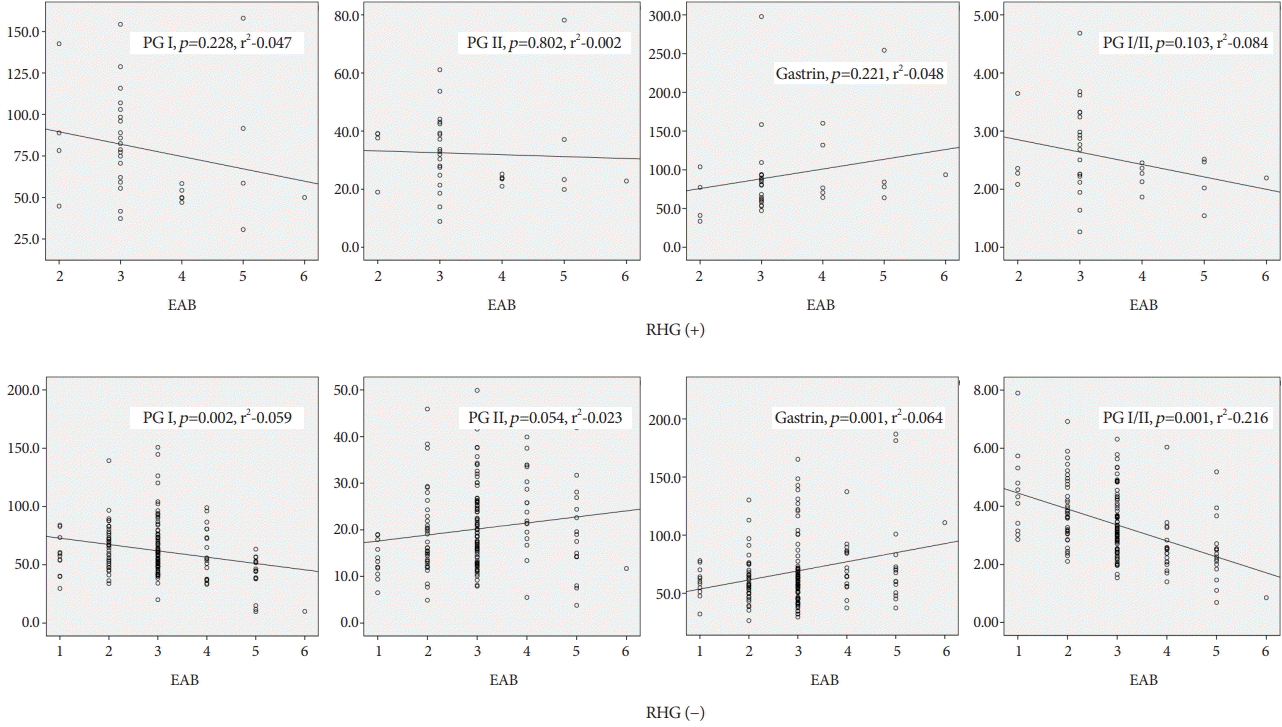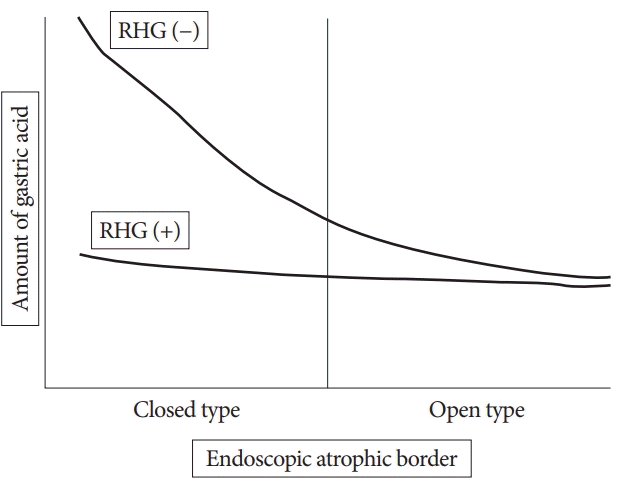1. Misiewicz JJ, Tytgat GNJ, Goodwin CS, et al. The Sydney system: a new classification of gastritis. In : Working Party Reports of the World Congresses of Gastroenterology; 1990 Aug 26-31; Sydney, Australia. Melbourne: Blackwell Scientific;1990. 1–10.
2. Rohrmann CA Jr, Seaman WB. Nonneoplastic lesions of the stomach. Margulis AR, Burhenne HJ, et al. Alimentary tract radiology. 4th ed. St. Louis: Mosby;1989. p. 551–593.
3. Komorowski RA, Caya JG. Hyperplastic gastropathy. Clinicopathologic correlation. Am J Surg Pathol. 1991; 15:577–585.
4. Lee I. Critical pathogenic steps to high risk Helicobacter pylori gastritis and gastric carcinogenesis. World J Gastroenterol. 2014; 20:6412–6419.
5. Correa P. Human gastric carcinogenesis: a multistep and multifactorial process--First American Cancer Society Award lecture on cancer epidemiology and prevention. Cancer Res. 1992; 52:6735–6740.
6. Watanabe M, Kato J, Inoue I, et al. Development of gastric cancer in nonatrophic stomach with highly active inflammation identified by serum levels of pepsinogen and Helicobacter pylori antibody together with endoscopic rugal hyperplastic gastritis. Int J Cancer. 2012; 131:2632–2642.
7. Yasunaga Y, Shinomura Y, Kanayama S, et al. Increased production of interleukin 1 beta and hepatocyte growth factor may contribute to foveolar hyperplasia in enlarged fold gastritis. Gut. 1996; 39:787–794.

8. Nishibayashi H, Kanayama S, Kiyohara T, et al. Helicobacter pylori-induced enlarged-fold gastritis is associated with increased mutagenicity of gastric juice, increased oxidative DNA damage, and an increased risk of gastric carcinoma. J Gastroenterol Hepatol. 2003; 18:1384–1391.

9. Murayama Y, Miyagawa J, Shinomura Y, et al. Morphological and functional restoration of parietal cells in helicobacter pylori associated enlarged fold gastritis after eradication. Gut. 1999; 45:653–661.

10. Lee OJ, Lee EJ, Kim HJ. Correlations among gastric juice pH and ammonia, Helicobacter pylori infection and gastric mucosal histology. Korean J Intern Med. 2004; 19:205–212.

11. Stolte M, Eidt S, Ohnsmann A. Differences in Helicobacter pylori associated gastritis in the antrum and body of the stomach. Z Gastroenterol. 1990; 28:229–233.
12. Uemura N, Okamoto S, Yamamoto S, et al. Helicobacter pylori infection and the development of gastric cancer. N Engl J Med. 2001; 345:784–789.
13. Wagner S, Haruma K, Gladziwa U, et al. Helicobacter pylori infection and serum pepsinogen A, pepsinogen C, and gastrin in gastritis and peptic ulcer: significance of inflammation and effect of bacterial eradication. Am J Gastroenterol. 1994; 89:1211–1218.
14. Iijima K, Sekine H, Koike T, Imatani A, Ohara S, Shimosegawa T. Serum pepsinogen concentrations as a measure of gastric acid secretion in Helicobacter pylori-negative and -positive Japanese subjects. J Gastroenterol. 2005; 40:938–944.

15. Massarrat S, Haj-Sheykholeslami A, Mohamadkhani A, et al. Pepsinogen II can be a potential surrogate marker of morphological changes in corpus before and after H. pylori eradication. Biomed Res Int. 2014; 2014:481607.
16. Iijima K, Koike T, Abe Y, Shimosegawa T. Cutoff serum pepsinogen values for predicting gastric acid secretion status. Tohoku J Exp Med. 2014; 232:293–300.

17. Kamada T, Haruma K, Inoue K, Shiotani A. [Helicobacter pylori infection and endoscopic gastritis -Kyoto classification of gastritis]. Nihon Shokakibyo Gakkai Zasshi. 2015; 112:982–993.
18. Nomura S, Terao S, Adachi K, et al. Endoscopic diagnosis of gastric mucosal activity and inflammation. Dig Endosc. 2013; 25:136–146.

19. Cho JH, Chang YW, Jang JY, et al. Close observation of gastric mucosal pattern by standard endoscopy can predict Helicobacter pylori infection status. J Gastroenterol Hepatol. 2013; 28:279–284.

20. Lee SY. Endoscopic gastritis, serum pepsinogen assay, and Helicobacter pylori infection. Korean J Intern Med. 2016; 31:835–844.

21. Morrison S, Dahms BB, Hoffenberg E, Czinn SJ. Enlarged gastric folds in association with Campylobacter pylori gastritis. Radiology. 1989; 171:819–821.

22. Yamamichi N, Hirano C, Ichinose M, et al. Atrophic gastritis and enlarged gastric folds diagnosed by double-contrast upper gastrointestinal barium X-ray radiography are useful to predict future gastric cancer development based on the 3-year prospective observation. Gastric Cancer. 2016; 19:1016–1022.

23. Yasunaga Y, Shinomura Y, Kanayama S, et al. Improved fold width and increased acid secretion after eradication of the organism in Helicobacter pylori associated enlarged fold gastritis. Gut. 1994; 35:1571–1574.

24. El-Omar EM, Oien K, El-Nujumi A, et al. Helicobacter pylori infection and chronic gastric acid hyposecretion. Gastroenterology. 1997; 113:15–24.

25. Kekki M, Maaroos HI, Sipponen P, et al. Grade of Helicobacter pylori colonisation in relation to gastritis: a six-year population-based follow-up study. Scand J Gastroenterol Suppl. 1991; 186:142–150.
26. Kang JM, Kim N, Yoo JY, et al. The role of serum pepsinogen and gastrin test for the detection of gastric cancer in Korea. Helicobacter. 2008; 13:146–156.

27. Vaughan WW, Gunter JU, Erwin EA. Enlarged gastric rugae: a correlation of the roentgenologic, gastroscopic, pathologic, and clinical findings; analysis of 41 cases. Radiology. 1951; 56:813–831.
28. Liu Y, Vosmaer GD, Tytgat GN, Xiao SD, Ten Kate FJ. Gastrin (G) cells and somatostatin (D) cells in patients with dyspeptic symptoms: Helicobacter pylori associated and non-associated gastritis. J Clin Pathol. 2005; 58:927–931.

29. Ruiz B, Correa P, Fontham ET, Ramakrishnan T. Antral atrophy, Helicobacter pylori colonization, and gastric pH. Am J Clin Pathol. 1996; 105:96–101.
30. Kitamura S, Muguruma N, Okamoto K, et al. Clinicopathological assessment of gastric xanthoma as potential predictive marker of gastric cancer. Digestion. 2017; 96:199–206.

31. Sugimoto M, Ban H, Ichikawa H, et al. Efficacy of the Kyoto classification of gastritis in identifying patients at high risk for gastric cancer. Intern Med. 2017; 56:579–586.









 PDF
PDF Citation
Citation Print
Print



 XML Download
XML Download